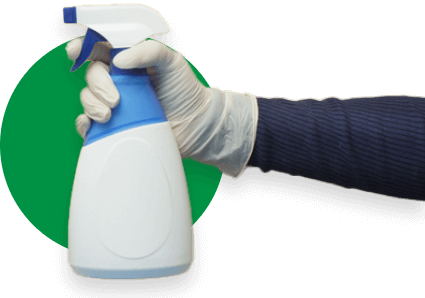Over the last few years, disinfecting offices in Dallas has become paramount, particularly in light of seasonal illnesses like the flu. Aside from the general benefits of cleanliness, failing to keep a tidy office can lead to legal issues like worker’s compensation claims, violation of OSHA workplace cleanliness standards, public health violations, and breach of duty of care all employers possess.
Fortunately, hiring a Dallas janitorial service to clean your office building regularly can help you comply with CDC, EPA, and OSHA guidelines.
If you’re not aware of these specific guidelines, you’re in luck! Here’s what you need to know about keeping your office space clean and disinfected.
CDC and EPA Guidelines for Disinfecting Offices
According to the CDC, frequently touched surfaces in the office should be disinfected at least once a day. Thorough cleaning reduces the spread of infectious diseases, which can make the office a cesspool for illness.
What are high-touch surfaces? These include door handles, elevator buttons, desks, keyboards, and phones. All of these are hotspots for germs and must be disinfected at least once a day.
Using EPA-approved disinfectants helps guarantee surfaces are effectively treated and provide the necessary protection against viruses and bacteria. If you’re unsure if a product is EPA-approved, you can check for the “EPA Reg. No.” on the label.
Don’t Forget About Air Quality When Disinfecting Offices
In addition to surface disinfection, maintaining good indoor air quality is crucial for preventing disease spread in office environments. The EPA’s Air Quality Guidelines emphasize the importance of proper ventilation and HVAC maintenance.
Well-functioning and maintained HVAC systems help filter out airborne pathogens and improve air circulation, reducing the concentration of potentially harmful particles. Routine cleaning and inspection of HVAC systems, as well as the use of high-efficiency filters, play a pivotal role in keeping office air fresh and safe.
Key Areas to Disinfect Offices
High-traffic areas like lobbies, restrooms, break rooms, and conference rooms should be a priority for frequent cleaning and disinfecting. In fact, these should be areas where frequency is increased.
Disinfecting offices involves the use of several products and procedures. You’ll need Clorox cleaner with bleach, dusters, brooms, dustpans, vacuums, sponges, and glass cleaner. That’s just the tip of the iceberg.
PRO-TIP: Follow the five, standard cleaning procedures: dusting, sweeping, mopping, scrubbing, and disinfecting.
A regular cleaning schedule keeps germs, dust, and particulates out of the air and off of frequently used surfaces.
Maintain a Clean Personal Workspace
Maintaining disinfected personal workspaces, such as desks and workstations, is essential for promoting a healthy office environment.
Since employees spend a significant portion of their day at their desks, these areas can easily accumulate germs.
We recommend educating employees about the importance of regularly disinfecting their shared work spaces. These discussions promote individual health and prevent the spread of illnesses throughout the office.
Wiping down surfaces regularly with EPA-approved disinfectants helps minimize the risk of germs spreading between colleagues. Best practices also include disinfecting equipment at the start and end of each workday, particularly in shared spaces or where hot-desking is common.
Providing the necessary cleaning supplies and clear guidance will empower employees to take charge of maintaining a healthy, clean workspace.
Preventing Disease Through Disinfecting Offices
Deep cleaning and routine disinfection are both necessary for commercial spaces. However, the difference lies in the level of detail involved.
✔️Routine disinfection is the daily wiping, sweeping, and dusting that keeps regularly used surfaces clean.
✔️Deep cleaning is scheduled periodically and involves a stringent set of standards.
Deep cleaning a Dallas office involves polishing hardwood floors, shampooing rugs and upholstery, restoring damaged floors, and scrubbing all office surfaces.
While deep cleans surely eliminate germs in the long term, routine disinfection mitigates germ growth between scheduled deep cleaning.
At Dallas Janitorial Services, we take special steps for disinfecting offices, especially in high-risk environments. We use electrostatic disinfection, a cutting-edge technology that involves a charged mist that we spray onto a surface. Upon spraying, the charged particles spread across the surface and begin disinfecting; no wiping is needed.
Legal and Financial Risks of Neglecting Office Disinfection
Poor disinfection practices can expose businesses to significant liability, especially if employees or customers fall ill due to unsanitary conditions.
OSHA standards require employers to maintain a safe and healthy workplace, and failing to do so can result in penalties or potential lawsuits.
Employees who suffer from illnesses related to inadequate cleaning protocols may file workers’ compensation claims or even pursue legal action for negligence. Similarly, customers may raise complaints or sue if they experience health issues linked to poor cleanliness.
Hiring a professional janitorial service like Dallas Janitorial Services for disinfecting offices guarantees companies are compliant with OSHA regulations. Our services mitigate these risks and help prevent legal liabilities through a clean and welcoming work environment.
Disinfecting Offices in Dallas,Texas
Dallas’s climate has unique challenges when it comes to disinfecting offices, particularly with our area’s humidity levels. Higher humidity increases the risk of mold and requires extra attention.
Dallas initiated a city-wide effort to maintain clean communities, so let us do our part in cleaning up the local community by disinfecting your office buildings.
At Dallas Janitorial Services, we are experts at following CDC and EPA guidelines for office cleaning. Our traditional and advanced cleaning methods result in highly satisfied customers, who enjoy a clean and sanitized office.
Clean, Safe, and Compliant Workplace
A clean, safe, compliant workplace helps your employees and customers. From advanced methods like electrostatic disinfection to scheduled deep cleaning, our professional disinfecting services ensure that your office is safe and healthy.
If you’re ready for a customized quote for your Dallas office building, Dallas Janitorial Services is here to help. Contact us today to learn more about how we can help you reduce liability risks by disinfecting offices.
Frequently Asked Questions About Cleaning and Disinfecting Offices
What are the five basic steps of cleaning and disinfection in offices?
The 5 important steps of cleaning and disinfection an office are:
- Pre-scrape any dirt and food on the surface.
- Wash the surface with an approved detergent.
- Rinse the surface with clear water or running water.
- Sanitize the surface.
- Allow the surface to air dry.
What are the 7 steps in the cleaning process?
The 7 steps in the professional cleaning process are:
- Removing debris
- Rinsing the surface for the first time
- Applying detergent
- Rinsing the surface again
- Sanitizing the surface
- Rinsing the surface for the last time
- Allowing the surface to dry
What is the proper way to clean and disinfect?
According to the CDC, the proper way to clean and disinfect is by cleaning with water, soap, and scrubbing. Then, they recommend sanitizing to reduce germs to levels public health codes or regulations consider safe. Always clean surfaces well before you disinfect them.
What are the CDC levels of disinfection?
The 3 levels of CDC disinfection are:
- Low-level – Noncritical items that will come in contact with intact skin.
- Intermediate-level – Semi critical items and noncritical items.
- High-level – Semi critical items that will come in contact with non intact skin, like dental and medical equipment.
What are 5 cleaning principles that should be applied in the office cleaning process?
The 5 cleaning principles that should be applied in the office cleaning process are:
- Time – Duration allotted to a cleaning task
- Temperature – Higher temperatures aid in chemical productivity
- Mechanical Action – Manually cleaning the surface or with a machine
- Chemical Reaction – Using cleaning chemicals to sanitize
- Procedures – Proper cleaning procedures ensure effectiveness







